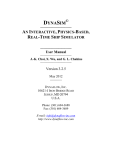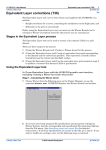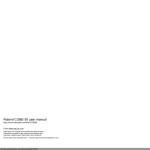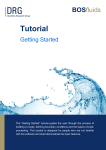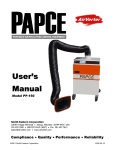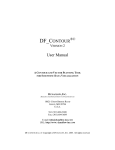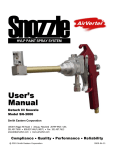Download 3DYNAPVF™ - Dynaflow, Inc.
Transcript
DYNAFLOW, INC. 3DYNAPVF™ - USER MANUAL: 7-084 3DYNAPVF™ __________________ Post-Processing Software for 3DYNAFS© Pressure and Velocity Field Computation __________________ User Manual __________________ G. L. Chahine and C.-T. Hsiao __________________ Version 2009-2 April 2009 __________________ DYNAFLOW, INC. 10621-J IRON BRIDGE ROAD Jessup, MD 20794 U.S.A. Phone: (301) 604-3688 Fax: (301) 604-3689 e-mail: [email protected] http://www.dynaflow-inc.com 1 DYNAFLOW, INC. 3DYNAPVF™ - USER MANUAL: 7-084 TABLE OF CONTENTS TABLE OF CONTENTS ......................................................................................................... 2 LIST OF FIGURES ................................................................................................................. 3 LICENSE AGREEMENT ....................................................................................................... 4 DESCRIPTION OF 3DYNAPVF™......................................................................................... 5 USING 3DYNAPVF™ .............................................................................................................. 8 INPUT FILES .......................................................................................................................... 8 OUTPUT FILES ....................................................................................................................... 9 SAMPLE CASE STUDIES ................................................................................................... 10 2 DYNAFLOW, INC. 3DYNAPVF™ - USER MANUAL: 7-084 LIST OF FIGURES Figure 1. Flow Field Around an Expanding Bubble in Gravity. ........................... 11 Figure 2. Flow Field Around an Expanding Bubble Near an Infinite Plate. ....... 12 Figure 3. Flow Field Around Two Bubbles Interacting under a Free Surface. ... 13 Figure 4. Flow Field Around a Bubble Collapsing Above a Stationary Rigid Cylinder. ........................................................................................................... 14 Figure 5. Flow Field Around Six Airguns Near a Test Panel. .............................. 15 3 DYNAFLOW, INC. 3DYNAPVF™ - USER MANUAL: 7-084 LICENSE AGREEMENT This agreement governs your use of the 3DYNAPVFTM product and any material enclosed with it, including any manuals, disks, and computer programs. Grant of License. This agreement permits you to use one copy of the Software, which is licensed as a single product. The software is “in use” on a computer when it is loaded into the temporary memory (i.e. RAM) or installed into the permanent memory (e.g., hard disk or other storage device) of that computer. You may use the Software on a network provided you have purchased one copy for each user. (Contact us about multiple user discounts.) Copyright and Restrictions. The software is owned by DYNAFLOW, INC. and is protected by United States copyright laws. You must treat the Software like any other copyrighted material, except that you may make one copy of the Software solely for backup archival purposes. You may not reverse engineer, decompile or disassemble the Software, except to the extent applicable law expressly prohibits the foregoing restriction. DYNAFLOW, INC. may have patents and/or pending patent applications covering subject matters in this document. The furnishing of this document does not give you any license to these patents. DYNAFLOW, INC. grants you a non-exclusive license to use one copy of the 3DYNAPVFTM software for the duration specified in your license agreement document signed by a DYNAFLOW, INC. official representative. Limited Warranty. For thirty (30) days from your date of purchase, DYNAFLOW, INC. warrants that the media on which the Software is distributed are free from defects in materials and workmanship. DYNAFLOW, INC. will, repair or replace the Software provided that the defective Software media is returned to DYNAFLOW, INC. or an authorized dealer within 30 days from the date of purchase. Limitation of Liabilities. In no event will DYNAFLOW, INC. be liable for any indirect, special, incidental, economic or consequential damages arising out of the use of or inability to use the Software. In no event will DYNAFLOW, INC.’s liability exceed the amount paid by you for the Software. DYNAFLOW makes no expression of suitability of the present product for any purpose, except that it will reproduce on a suitable computer the documented cases at the end of this report, and work properly for similar cases. Restricted Rights. No part of this document may be reproduced or transmitted in any form or by any means, electronic or mechanical, for any purpose, without the express written permission of DYNAFLOW, INC. Other brands or product names are trademarks or registered trademarks of their respective holders. 4 DYNAFLOW, INC. 3DYNAPVF™ - USER MANUAL: 7-084 DESCRIPTION OF 3DYNAPVF™ 3DYNAPVF™ is a post processing program for 3DYNAFS™© that computes the pressure and velocity fields in a specified space region at a given time step. Details of the state of the fluid domain (e.g., the velocity and pressure fields) can be obtained by the post-processing technique described below. 3DYNAPVF™ is a companion program to the 3DYNAFS™© code. The application of Green’s identity equation enables the calculation of the potential at any point inside the fluid domain. In this case no linear system needs to be solved since at the end of a given time step all the quantities on the boundaries are known. In the post-processing code, the values of potential and normal velocity from the boundaries only (i.e. bubble and boundary surfaces) are read from files saved during the execution of the main 3DYNAFS™© code, as are the coordinates and connectivity of the boundary points. The discrete equivalent of the Green’s identity yields the value of the potential at the desired field point P as, n 1 1 2 n 2 P G1, G2 , ..., GN H , H , ..., H 1 2 N , N n N (1) where is the solid angle from which P locally “sees” the domain. Equation (1) enables one to compute the potential on the prescribed grid points. These presently form a uniform Cartesian grid of points overlaid on the flow field. The grid is entered by the user by choosing the lower left corner and the upper right corner of the grid the number of grid points in the x, y and z directions. The boundary integral equations are derived from the conservation equations of the fluid, and apply to the fluid domain only. Thus, they are not valid inside solid structures or inside the bubble. After the coordinates of the grid points are generated, a first pass is made to determine if they are in the fluid or not. Points inside bubbles and/or bodies are identified, and excluded from the following potential computation. The velocity components at these points are presently set to zero. For those points inside bubbles 5 DYNAFLOW, INC. 3DYNAPVF™ - USER MANUAL: 7-084 the pressure is set equal to the pressure inside the bubble and for those points inside the body the pressure is set to zero. The velocity field is given by the potential derivatives. For the points in the fluid, we use second order central differences to compute the derivatives, for example: u( x) ( x dx) ( x dx) 2x . (2) In the case where the point is near the surface of the bubble, a simple one-sided difference equation is used. In addition to the computations of the velocity at the grids, the velocities at the bubble nodes are also available. These, along with all velocities at the grid points, are then output to files for graphical processing. The pressure at a point in the fluid domain is given by the unsteady Bernoulli equation. 1 p p0 g ( z z0 ) , t 2 (3) where p0 is the ambient pressure at z0 .This requires the knowledge of potential time derivatives. The potential time derivatives can also be computed using Green’s identity 2 t 1 n t 1 2 nt 2 t 2 P G1, G2 , ..., GN H , H , ..., H 1 2 N . (4) t 2 t N nt N For a Fluid Structure Interaction FSI case run, the potential time derivatives is computed based on a finite difference scheme using potential from two consecutive time steps, i.e. 6 DYNAFLOW, INC. 3DYNAPVF™ - USER MANUAL: 7-084 n1 n . t t (5) These values are then substituted in equation (3) to obtain the pressure. The pressure is set to zero if the pressure is negative. 7 DYNAFLOW, INC. 3DYNAPVF™ - USER MANUAL: 7-084 USING 3DYNAPVF™ Input Files To start running 3DYNAPVF™ the user needs to have the following input files: DATA_IN REC##### RECOVER_FSI##### FIELD_DATA.DAT The input files, DATA_IN, are the same input files used in the 3DYNAFS run. The recover file, REC#####, is automatically generated after the user runs 3DYNAFS and RECOVER_FSI#####, is automatically generated if running a FSI case. In addition, the user needs to provide the file FIELD_DATA.DAT. FIELD_DATA.DAT The user needs to specify the size of the computational domain and the number of grid points in FIELD_DATA.DAT. The user can also specify the plane used to ‘cross-cut’ the domain. The plane is defined by: ax + by + cz = d. An example of the FIELD_DATA.DAT is shown below: Example Value 1000 0 13 41 0 0 13 41 1 -13 13 81 0 1 Variable Name File umber xmin, ymin, zmin xmax, ymax, zmax nxgrid, nygrid, nzgrid a, b, c, d Line 1: Specify the number of recover file the user wants to compute the flow field. Line 2: Specify the coordinates of the lower left point of the computational domain. Line 3: Specify the coordinates of the upper right point of the computational domain. Line 4: Specify the number of grid points Line 5: Specify the plane to crosscut the objects Tip: The user can specify a two-dimensional domain of a 3-D domain by setting the number of grid points of a dimension, eg. z dimension, equal to 1. The user also can 8 DYNAFLOW, INC. 3DYNAPVF™ - USER MANUAL: 7-084 compute the flow field at a single point by setting all numbers of grid points equal to 1, ie. nxgrid = nygrid = nzgrid = 1. In this case the coordinates of the considered point are (xmin, ymin, zmin). Output Files PVF#####.plt This file is for visualization of the result by using Tecplot ®. Tecplot® is a visualization program developed by Amtec Engineering Inc. This file contains the pressure, velocity and potential output generated by the post processing program. X,Y,Z are the coordinates of the grid point, U,V,W are the components of the velocity, P and are the pressure and the potential. In addition to the Tecplot® header at the beginning of the file, the file is stored in the following format: do k=1,nzgrid do j=1,nygrid do i=1,nxgrid X(i,j,k), Y(i,j,k) , Z(i,j,k), P(i,j,k), U(i,j,k), V(i,j,k), W(i,j,k), end do end do end do (i,j,k) If the user prefers to use another graphing software, the file can be edited to remove the Tecplot® header and replace by whatever is necessary. Dynaflow can also provide a version with another output format if the user so specifies at a norminal fee. 9 DYNAFLOW, INC. 3DYNAPVF™ - USER MANUAL: 7-084 SAMPLE CASE STUDIES The following examples illustrate the results obtained with 3DYNAPVF™. These consist of: BUBBLE DYNAMICS IN A GRAVITY FIELD BUBBLE DYNAMICS NEAR AN INFINITE WALL TWO BUBBLE INTERACTION UNDER FREE SURFACE BUBBLE DYNAMICS NEAR A STATIONARY RIGID CYLINDER SIX AIRGUNS NEAR A DEFORMABLE BOX (FSI CASE) In the following pages we present each of these cases to help the user to get used to utilizing 3DYNAPVF™. 10 DYNAFLOW, INC. 3DYNAPVF™ - USER MANUAL: 7-084 Flow Field Around an Expanding Bubble in Gravity Tips: 1. All inputs in this example are in SI units. 10 8 p 1.5E+06 1.4E+06 1.3E+06 1.2E+06 1.1E+06 1E+06 900000 800000 700000 600000 300000 z 6 4 2 0 -2 -6 -4 -2 0 2 4 6 x Figure 1. Flow Field Around an Expanding Bubble in Gravity. The results shown in Figure 1 required the following inputs. field_data.dat file 800 -6 0.0 -2 6 0.0 10 51 1 51 0 1 0 0 Recover File Number xmin,ymin,zmin [m] xmax,ymax,zmax [m] nx, ny, nz a, b, c, d 11 DYNAFLOW, INC. 3DYNAPVF™ - USER MANUAL: 7-084 Flow Field Around a Bubble near an Infinite Plate Tips: 1. Ensure that one of the ends of the zone defined for the flow field is just inside the infinite plate. 0.15 0.1 p 1E+06 900000 800000 700000 600000 500000 400000 300000 200000 87808.1 z 0.05 0 -0.05 -0.1 -0.15 -0.15 -0.1 -0.05 0 0.05 0.1 0.15 x Figure 2. Flow Field Around an Expanding Bubble Near an Infinite Plate. The result shown in Figure 2 required the following inputs. 1000 -0.15 0.0 0.15 0.0 51 1 0 1 -0.15 0.15 51 0 0 Recover File Number xmin,ymin,zmin [m] xmax,ymax,zmax [m] nx, ny, nz a, b, c, d 12 DYNAFLOW, INC. 3DYNAPVF™ - USER MANUAL: 7-084 2 Interaction of Two Bubbles Under a Free Surface 1 p z 2E+06 1.8E+06 1.6E+06 1.4E+06 1.2E+06 1E+06 800000 600000 400000 200000 108791 73178 0 -200000 0 -1 -2 -2 -1 0 1 2 y Figure 3. Flow Field Around Two Bubbles Interacting under a Free Surface. The result shown in Figure 4 required the following inputs. 1000 Recover file number 0. -2 -2 xmin,ymin,zmin [m] 0. 2 1 xmax,ymax,zmax [m] 1 81 61 nx, ny, nz 1 0 0 0 a, b, c, d 13 DYNAFLOW, INC. 3DYNAPVF™ - USER MANUAL: 7-084 Flow Field from a Bubble Collapsing Over a Stationary Rigid Cylinder 0.04 p 0.02 10000 9500 9000 8500 8000 7500 7000 6500 6000 5500 5000 4500 4000 3500 3000 0 z -0.02 -0.04 -0.06 -0.08 -0.05 0 0.05 y Figure 4. Flow Field Around a Bubble Collapsing Above a Stationary Rigid Cylinder. The result shown in Figure 4 required the following inputs. 1200 Recover file number 0. -0.07 -0.09 xmin,ymin,zmin [m] 0. 0.07 0.05 xmax,ymax,zmax [m] 1 71 71 nx, ny, nz 1 0 0 0 a, b, c, d 14 DYNAFLOW, INC. 3DYNAPVF™ - USER MANUAL: 7-084 10 Flow Field Around Six Airguns Near Test Panel 8 p y 280000 260000 240000 220000 200000 180000 160000 140000 120000 100000 80000 60000 40000 20000 6 4 2 -4 -2 0 2 4 x Figure 5. Flow Field Around Six Airguns Near a Test Panel. The result shown in Figure 4 required the following inputs. 2000 File number -5 2 -3 xmin,ymin,zmin 5 6 -3 xmax,ymax,zmax 40 32 1 nxgrid, nygrid, nzgrid 0 0 1 -3 acoef, bcoef, coef, d 15















